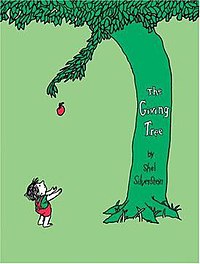The Giving Tree

Cover depicting the tree giving away an apple
|
|
| Author | Shel Silverstein |
|---|---|
| Genre | Children's picture book |
| Publisher | Harper & Row |
|
Publication date
|
October 7, 1964 |
| ISBN | |
The Giving Tree is a children's picture book written and illustrated by Shel Silverstein. First published in 1964 by Harper & Row, it has become one of Silverstein's best known titles and has been translated into numerous languages.
Despite the recognition that the book has received, it has been described as "one of the most divisive books in children’s literature." The controversy concerns whether the relationship between the main characters (a boy and a tree) should be interpreted as positive (e.g., the tree gives the boy selfless love) or as negative (e.g., the boy and the tree have an abusive relationship).Scholastic designates the interest level of this book to range from kindergarten to second grade.
Silverstein had difficulty finding a publisher for The Giving Tree. An editor at Simon & Schuster rejected the book's manuscript because he felt that it was "too sad" for children and "too simple" for adults.Tomi Ungerer encouraged Silverstein to approach Ursula Nordstrom, who was a publisher with Harper & Row.
An editor with Harper & Row stated that Silverstein had made the original illustrations "scratchy" like his cartoons for Playboy, but that he later reworked the art in a "more pared-down and much sweeter style." The final black-and-white drawings have been described as "unadorned… visual minimalism." Harper & Row published a small first edition of the book, consisting of only 5,000-7,500 copies, in 1964.
The book follows the lives of a female apple tree and a boy, who develop a relationship with one another. The tree is very "giving" and the boy evolves into a "taking" teen-ager, man, then elderly man. Despite the fact that the boy ages in the story, the tree addresses the boy as "Boy" his entire life.
In his childhood, the boy enjoys playing with the tree, climbing her trunk, swinging from her branches, and eating her apples. However, as the boy grows older, he spends less time with the tree and tends to visit her only when he wants material items at various stages of his life. In an effort to make the boy happy at each of these stages, the tree gives him parts of herself, which he can transform into material items, such as money (from her apples), a house (from her branches), and a boat (from her trunk). With every stage of giving, "the Tree was happy".
...
Wikipedia
